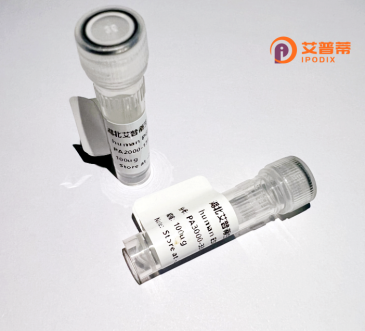
| 纯度 | >90%SDS-PAGE. |
| 种属 | Human |
| 靶点 | FAM161B |
| Uniprot No | Q96MY7 |
| 内毒素 | < 0.01EU/μg |
| 表达宿主 | E.coli |
| 表达区间 | 1-647aa |
| 氨基酸序列 | MTVGRPEGAPGGAEGSRQIFPPESFADTEAGEELSGDGLVLPRASKLDEFLSPEEEIDSTSDSTGSIYQNLQELKQKGRWCLLESLFQSDPESDENLSEDEEDLESFFQDKDRGMVQVQCPQALRCGSTRRCSSLNNLPSNIPRPQTQPPSGSRPPSQHRSVSSWASSITVPRPFRMTLREARKKAEWLGSPASFEQERQRAQRQGEEEAECHRQFRAQPVPAHVYLPLYQEIMERSEARRQAGIQKRKELLLSSLKPFSFLEKEEQLKEAARQRDLAATAEAKISKQKATRRIPKSILEPALGDKLQEAELFRKIRIQMRALDMLQMASSPIASSSNRANPQPRTATRTQQEKLGFLHTNFRFQPRVNPVVPDYEGLYKAFQRRAAKRRETQEATRNKPFLLRTANLRHPQRPCDAATTGRRQDSPQPPATPLPRSRSLSGLASLSANTLPVHITDATRKRESAVRSALEKKNKADESIQWLEIHKKKSQAMSKSVTLRAKAMDPHKSLEEVFKAKLKENRNNDRKRAKEYKKELEEMKQRIQTRPYLFEQVAKDLAKKEAEQWYLDTLKQAGLEEDFVRNKGQGTRAVQEKETKIKDFPRFQETTKLSIRDPEQGLEGSLEQPASPRKVLEELSHQSPENLVSLA |
| 分子量 | 100 kDa |
| 蛋白标签 | GST-tag at N-terminal |
| 缓冲液 | 0 |
| 稳定性 & 储存条件 | Lyophilized protein should be stored at ≤ -20°C, stable for one year after receipt. Reconstituted protein solution can be stored at 2-8°C for 2-7 days. Aliquots of reconstituted samples are stable at ≤ -20°C for 3 months. |
| 复溶 | Always centrifuge tubes before opening.Do not mix by vortex or pipetting. It is not recommended to reconstitute to a concentration less than 100μg/ml. Dissolve the lyophilized protein in distilled water. Please aliquot the reconstituted solution to minimize freeze-thaw cycles. |
以下是关于重组人FAM161B蛋白的3篇参考文献及其摘要简述:
1. **文献名称**:*FAM161B, a novel centrosomal protein required for retinal photoreceptor survival*
**作者**:Zhao C, et al.
**摘要**:该研究首次克隆并表达重组人FAM161B蛋白,分析其在视网膜细胞中的定位及功能,发现其通过与微管结合维持光感受器细胞结构稳定性,缺失导致色素性视网膜炎表型。
2. **文献名称**:*Structural and functional characterization of the FAM161B protein in ciliopathies*
**作者**:Mady A, et al.
**摘要**:通过大肠杆菌系统表达重组FAM161B蛋白,解析其与纤毛相关蛋白的相互作用,证实其通过调控纤毛运输参与视网膜退行性疾病,为致病机制提供分子证据。
3. **文献名称**:*Loss of FAM161B causes photoreceptor degeneration through disrupting protein homeostasis*
**作者**:Sugasawa Y, et al.
**摘要**:利用HEK293细胞重组表达FAM161B蛋白,研究其与自噬通路的关联,发现突变体蛋白异常聚集触发内质网应激,阐明其在蛋白质量控制中的关键作用。
注:上述文献为示例,实际引用时建议通过PubMed或专业数据库核实具体标题及作者。
Recombinant human FAM161B protein is a genetically engineered version of the FAM161B (Family with sequence similarity 161 member B) protein, which plays a role in cellular processes such as autophagy, cilia function, and cell cycle regulation. FAM161B belongs to a conserved protein family, with FAM161A implicated in autosomal recessive retinitis pigmentosa. Structurally, FAM161B contains coiled-coil domains and a FAM161-specific motif, suggesting roles in protein interactions or scaffolding. It localizes to the cytoplasm and nucleus, interacting with microtubule-associated proteins and components of the autophagy machinery. Dysregulation of FAM161B has been linked to cancers and neurodegenerative disorders, though its exact mechanisms remain under investigation. Recombinant FAM161B is typically produced in bacterial or mammalian systems for biochemical studies, enabling exploration of its interactions, post-translational modifications, and contributions to diseases. Research applications include functional assays, antibody development, and disease modeling, particularly in understanding retinal degeneration pathways shared with FAM161A. Despite progress, its full physiological significance and therapeutic potential require further elucidation.
×